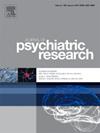Treatment outcomes for typical and atypical anorexia nervosa across Asian and non-Asian patients in United States higher level of care facilities
IF 3.7
2区 医学
Q1 PSYCHIATRY
引用次数: 0
Abstract
Asian patients with Anorexia Nervosa (AN) face unique barriers to recovery, but may also disproportionately experience constitutional thinness. The current study compared weight-gain and psychopathology treatment outcomes between Asian and non-Asian patients, and compared patients who reached their Expected Body Weight (EBW) by discharge to those who did not. We collected data from Asian (n = 25 adults, 40 adolescents) and non-Asian (n = 966 adults, 1067 adolescents) patients in higher levels of care at United States eating disorder treatment facilities. We conducted multivariate, two-way, and mixed model ANOVAs to compare symptom severity for Asian versus non-Asian adults and adolescents at admission, discharge, and across treatment. We additionally conducted mixed model ANOVAs to compare change in psychopathology across treatment for Asian and non-Asian patients who did and did not meet their EBW by discharge. No significant differences emerged between Asian and non-Asian patients, although some differences were noted between age groups at admission and discharge. For non-Asian patients only, those who reached their EBW by discharge had, on average, significantly higher levels of restriction, shape and weight concerns, and global concerns. Results suggest that Asian and non-Asian patients similarly benefit from treatment for AN.
美国高水平护理机构中亚洲和非亚洲患者典型和非典型神经性厌食症的治疗结果
亚洲神经性厌食症(AN)患者面临着独特的康复障碍,但也可能不成比例地经历体质消瘦。目前的研究比较了亚洲和非亚洲患者的体重增加和精神病理治疗结果,并比较了出院时达到预期体重(EBW)的患者和未达到预期体重的患者。我们收集了来自亚洲(n = 25名成年人,40名青少年)和非亚洲(n = 966名成年人,1067名青少年)患者的数据,这些患者在美国饮食失调治疗机构接受更高水平的护理。我们进行了多变量、双向和混合模型方差分析来比较亚裔和非亚裔成人和青少年在入院、出院和整个治疗期间的症状严重程度。此外,我们还进行了混合模型方差分析,以比较在出院时达到或未达到EBW的亚洲和非亚洲患者在治疗期间精神病理的变化。亚洲和非亚洲患者之间没有显著差异,尽管入院和出院时不同年龄组之间存在一些差异。仅对于非亚洲患者,那些在出院时达到EBW的患者,平均而言,限制水平、形状和体重问题以及全球问题都要高得多。结果表明,亚洲和非亚洲患者从AN治疗中获益相似。
本文章由计算机程序翻译,如有差异,请以英文原文为准。
求助全文
约1分钟内获得全文
求助全文
来源期刊

Journal of psychiatric research
医学-精神病学
CiteScore
7.30
自引率
2.10%
发文量
622
审稿时长
130 days
期刊介绍:
Founded in 1961 to report on the latest work in psychiatry and cognate disciplines, the Journal of Psychiatric Research is dedicated to innovative and timely studies of four important areas of research:
(1) clinical studies of all disciplines relating to psychiatric illness, as well as normal human behaviour, including biochemical, physiological, genetic, environmental, social, psychological and epidemiological factors;
(2) basic studies pertaining to psychiatry in such fields as neuropsychopharmacology, neuroendocrinology, electrophysiology, genetics, experimental psychology and epidemiology;
(3) the growing application of clinical laboratory techniques in psychiatry, including imagery and spectroscopy of the brain, molecular biology and computer sciences;
 求助内容:
求助内容: 应助结果提醒方式:
应助结果提醒方式:


